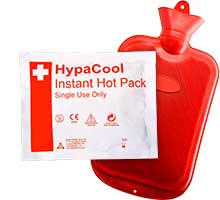
Heat therapy is a proven method of easing chronic muscle pain, soothing sore muscles and healing damaged tissue. It can be applied in many ways and is divided into two broad categories: dry heat and moist heat. Dry heat products are usually selected for their ease of use, consistent temperatures, convenience and portability. Moist heat products are used in cases that necessitate deeper heat penetration into muscle tissues.
Whereas cold therapy is useful for treating sprain and strain injuries as per the PRICE method, heat therapy is useful for the ongoing treatment of muscle soreness from exercise or chronic pain. It works by improving blood flow to a particular area through increased temperature, soothing discomfort and increasing muscle flexibility.
What kinds of pain does heat help?

Heat therapy accelerates the healing process by increasing the blood flow to the affected area. With increased blood flow comes increased levels of oxygen, platelets, white blood cells and essential nutrients; components which all help damaged tissue to heal.
Muscle Spasms
While muscle spasms are very common and are usually no cause for concern, many forms of chronic back pain involve spasms of the lower back muscles. Spasms can restrict circulation, which sends pain signals to the brain. Heat therapy dilates the blood vessels increasing circulation, relieving tightness in tense muscles and soothing pain.Menstrual Pain
Heat therapy has been a long-time home remedy for menstrual pain, and studies now show that heat’s pain-relief is backed by science as well. Applying heat to the lower back or lower abdomen increases blood flow and relaxes uterine contractions, which in turn relieves pain.Soothing sore muscles
Delayed onset muscle soreness (DOMS) is the ache typically felt 24 to 48 hours after a workout. Heat therapy brings increased blood flow to sore muscles and eases tension, relieving pain.Studies show that moist heat—such as is found in a sauna or steam room—is more effective than dry heat for relieving muscle soreness.
Easing stiffness
Muscle stiffness typically follows hard physical work like exercise or weightlifting, or after long periods of inactivity like sleeping or sitting for a long time. Applying heat to stiff muscles relaxes them and facilitates stretching of the surrounding adhesions and connective tissue, in turn relieving stiffness and increasing range of motion.
Muscle stiffness may also be a sign of other illnesses; seek medical attention if you experience muscle stiffness along with any of these symptoms:
- Severe muscle weakness
- Pain, swelling, and/or redness in the area that is stiff
- Fever, especially with stiffness of the neck
- Aching muscles that began after taking new medication
These symptoms may be a sign of a more serious underlying condition.
How to apply heat therapy using different methods
 Heat therapy is most beneficial when used for an extended period. Tension and minor stiffness can often be relieved with only 15 to 20 minutes of heat therapy, while stronger pain can be soothed with longer sessions of heat therapy, like with a heat wrap.
Heat therapy is most beneficial when used for an extended period. Tension and minor stiffness can often be relieved with only 15 to 20 minutes of heat therapy, while stronger pain can be soothed with longer sessions of heat therapy, like with a heat wrap.Dry heat therapy methods like instant heat packs or gel packs are more convenient for isolated muscle treatment or alleviating menstrual pain. Moist heat therapy methods like a steam room or warm bath are best suited to soothing multiple sore or stiff muscles after a tough workout.
Instant Heat Packs
Instant chemical heat packs use exothermic chemical reactions to release heat. They are typically made up of two plastic bags, one inside the other. The outer bag contains water, and the inner bag contains chemicals. When the inner bag is ruptured, a reaction occurs causing the bag to heat up rapidly.How to apply heat therapy using an instant chemical heat pack:
- Identify the inner bag of liquid and squeeze it to release its contents and begin the reaction.
- Massage or gently shake the heat pack to quicken the reaction. The pack will heat up and should stay hot for 20 to 25 minutes.
- Wrap the heat pack in a gel pack cover or a towel to provide insulation and prevent direct contact with the skin.
- Apply the heat pack to the afflicted area for the full active duration of the pack.
Reusable Heated Gel Pack
Reusable gel packs contain a water-based gel that can be warmed or cooled to use for either heat or cold therapy. These packs are useful for their versatility and reusability, but they require a microwave or freezer to be prepared.How to apply heat therapy using a reusable gel pack
- Place the gel pack on a paper towel and into the microwave for 30 to 60 seconds, depending on the power of your microwave.
- Your gel pack will now be warm and should retain its heat for up to 30 minutes.
- Wrap the gel pack in a gel pack cover or towel to prevent direct contact with the skin.
- Apply the gel pack to the afflicted area for as long as the pack remains warm.
Saunas, Steam Rooms and Warm Baths
When compared to dry heat therapy methods, moist heat can penetrate the skin deeper and faster, providing more thorough treatment directly to muscles. Moist heat methods like saunas, steam rooms and warm baths also make full-body treatment possible, which is ideal for recovery after an intense workout.Saunas
 A sauna is a room heated through various means to between 65 and 90 degrees, with humidity levels ranging between 10% and 60%. Frequent sauna usage is associated with improved cardiovascular health, and increases the benefits gained from regular intense exercise by accelerating the recovery period.
A sauna is a room heated through various means to between 65 and 90 degrees, with humidity levels ranging between 10% and 60%. Frequent sauna usage is associated with improved cardiovascular health, and increases the benefits gained from regular intense exercise by accelerating the recovery period.There is however a risk of overheating the body when using a sauna; it is important to limit the time that you spend inside as the high heat can lead to dizziness or even fainting. You should also avoid using saunas while pregnant or while under the influence of drugs, alcohol or certain medications.
Steam Rooms
Steam rooms are like saunas in that they are heated rooms designed to provide full-body moist heat therapy. The main difference is that steam rooms focus primarily on the level of humidity and are designed to accommodate between 95 and 100% humidity. The interior temperatures typically range from 40 to 50 degrees but may feel warmer because of the moisture.The moisture in steam rooms may relieve congestion and other flu symptoms, and helps to relieve muscle soreness. Just like saunas, use steam rooms with caution as the high temperatures can be dangerous.
Warm Baths
Warm baths are a convenient way to administer full-body moist heat therapy at home. A warm bath can quickly heat the body above its core temperature, with similar health benefits to a sauna or steam room.You should limit your time in a warm bath to 30 minutes to avoid the dangers of long exposure to high temperatures. If the temperature of the water exceeds 40 degrees, limit your time to 10 minutes.
Commonly Asked Questions
What are heat packs effective for?
Heat packs (whether instant chemical or reusable gel) are most effective when being used to treat localised pain like lower back stiffness, soreness in specific muscles or menstrual cramps. For wider-spread soreness like DOMS from intense exercise, other heat therapy methods like warm baths may be more effective.How long should you keep a heating pad on for?
Unlike cold therapy, heat therapy is more effective over longer periods of treatment. Minor muscle soreness or tension can often be relieved with 15 to 20 minutes of heat therapy. Moderate to severe pain like DOMS will benefit from longer sessions of heat therapy, from 30 minutes to a few hours, depending on the method used.Takeaway
Heat therapy is effective at relieving muscle stiffness and soreness by improving blood circulation to the treated area. Heat therapy should be used to treat common discomforts like back pain, menstrual pain or delayed onset muscle soreness. There are cases in which heat therapy should not be used, for example, if the affected area is swollen, bruised or an open wound.Cold therapy can also be an effective way of treating pain or discomfort but is useful in different circumstances to heat therapy. Curious about the differences between heat therapy and cold therapy? Read our article on cold therapy.
Read our blog for more information on first aid, or contact us for further advice and information on our products.
About the author:
Jo Stokes is a writer, marketer and trained first aider at First Aid Online.
Find out more about Jo.
By Jo Stokes

